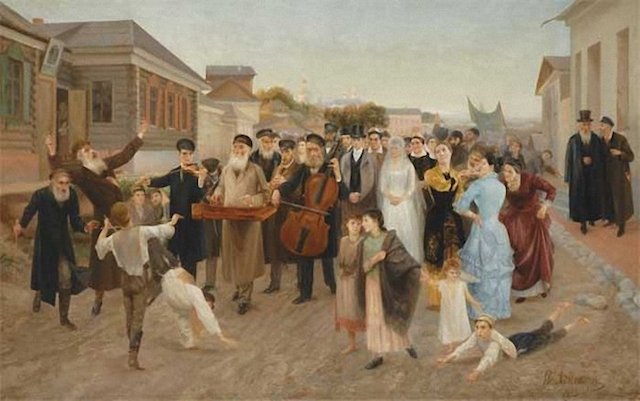Poland was a Jewish center for hundreds of years. This is a brief history.
Merchants Came Long Before Settlers
Immigration of Jewish settlers to Poland, which began in the first half of the thirteenth century, led to the establishment of settlements in the western part of its territory. Within the borders of the Great Duchy of Lithuania this immigration began only some 140 years later.
Earlier, merchants–mostly from Babylon, Persia, and the Caucasus–[had] crossed through the Slavic lands of Eastern Europe in search of markets in the West, and there were incidents of Jewish merchants, such as these who remained for a certain period (a few months or even years) engaging in incidental business or enterprises, such as the minting of coins at the request of local authorities (tenth and twelfth centuries) or in connection with trade in amber or valuable furs. The Jewish merchants also handled slaves, assigned to them by their Slavic masters for care and transfer to the lands of the Islamic ‘Abbasid empire.
This temporary presence of individual Jews or small Jewish groups in Polish lands in the tenth through twelfth centuries did not result in a permanent Jewish settlement there.But, in contrast to the political and economic situation of the earlier centuries, during the 1240sconditions developed which were conducive to a permanent Jewish settlement.
With your help, My Jewish Learning can provide endless opportunities for learning, connection and discovery.
Mutual Interests Led to Settlement
During this period, the Polish rulers endeavored to rehabilitate their ruined lands by attracting immigrants from neighboring Germany to settle in the unoccupied territories of the land. The princes and rulers of the land between the Oder River to the West and between the lands along the tributary streams of the Vistula River and its sources, the Bug and the San in the East, who strove to establish settlements in these areas, also looked favorably upon Jewish immigration from Germany to both old and new cities.
Many of the Ashkenazic Jews, who had been persecuted by the crusaders and by burghers who viewed them as undesirable rivals, found their way mainly to western Poland. With time, this movement of Jewish immigrants from Germany gave rise to a permanent Jewish settlement there. Not only did this migration from Germany, Bohemia, Austria, Italy, and Seljuk (and later Ottoman) Turkey aid the growth of Jewish settlement in Poland and Lithuania. Increasing sources of income, together with natural demographic development, also brought about a rise in Jewish population and Jewish communities in the kingdom of Poland and the Grand Duchy of Lithuania, which, in the mid‑fourteenth century, became united under one king.
The Best Little Charter Anywhere
The Jews of Poland learned from experience, and after a few years in their new settlements, they organized themselves into communities which would serve as a base for their continued existence there. To this end they also endeavored to obtain from the authority governing the land on which they were living, a charter of privileges and rights, and in 1264 Boleslaw the Pious, ruler of western Poland, granted this privilege. In an expanded form (beginning in 1453) this charter served the Jewish community of the entire kingdom of Poland and the Grand Duchy of Lithuania until the second half of the eighteenth century.
The terms of this political privilege, now established in the form of a written charter, granted the Jews the right to engage in commerce (including moneylending and financial transactions), trades and independent professions. It equally defended their personal and property rights and granted them communal autonomy (essentially the conduct of internal affairs of the Jewish community in accord with Jewish law and tradition), and also granted all Jews equality before the royal courts. The charter also required obligatory submission by the members of the Jews’ communities to their chosen leaders. Freedom of movement within the territories of the kingdom was also assured.
The expanded version of this privilege (1453) is to be counted, it would appear, among the best of those which Jews ever obtained from authorities in the medieval and early modern periods, whether in Europe or anywhere else. This situation also explains the establishment, from the fourteenth through sixteenth centuries, of more than 150 new Jewish communities in Polish territory, including the eastern regions which had been added to Poland.
But the Church Pushed for Restrictions
This privilege granted to the Jews also provided severe punishment for kidnapping and forced baptism of Jewish children, and for bringing false charges of ritual murder and host desecration. These protections and the general rights granted to Jews aroused the wrath of church authorities, and the papal legate convened a synod in Breslau (1267) which sought to bring about strict separation between Polish Christians and Jews. They also strove to reimpose on the Jews rules requiring that they wear special Jewish headgear and the infamous badge and prohibiting them from holding public offices or using the services of Christian wet-nurses and so on. In reality, resolutions such as these had little practical effect upon the status of the Jews.
Slavic Slaves Became Jewish Wives
During that time, the Church in Poland had not yet managed to become firmly established, and therefore strongly opposed any social or personal relations between the local populace and the Jews, who, upon arriving in Poland had set up small workshops and businesses. In these, they employed local Slavic slaves who aided them in developing their enterprises. The Jews were mostly single men, from Jewish centers in western and southern Europe, who in the normal course of affairs desired to found families.
As by Jewish law, after seven years they were required to free their slaves, often, the owner, when his female slave continued working with him after her release, proposed that she remain with him as his wife. and undertake the management of the household as an equal partner, all on condition that she convert to Judaism. This could also explain the Slavic cast which often manifests itself on the faces of Jews from this region. That practice also aroused the anger of the church authorities.
The Picture Was Not All Rosy
In the kingdom of Poland, Casimir III confirmed (1334) the privilege[s] granted to the Jews. Yet, there were attempts to restrict certain economic activities, particularly with regard to financial businesses, including also pawn brokerage and land mortgaging. When the Black Death ravaged much of Europe in 1348, Jews in both Poland and Germany were accused of poisoning the wells, and those in at least some of the cities were slaughtered.
The Jewish communities in Cracow and Posen became important during the early fourteenth century, if not earlier, and that of Lvov (Lemberg) soon joined them. [By 1650, 450,000 of Europe’s 550,000 Jews resided in the Polish Lithuanian kingdom, making it one of the most vital and significant Jewish communities in existence between the Spanish expulsion and WWII.]
Reprinted with permission from the author.



